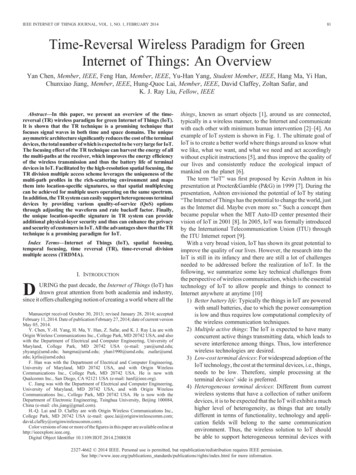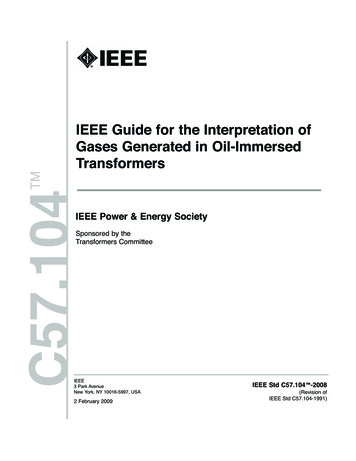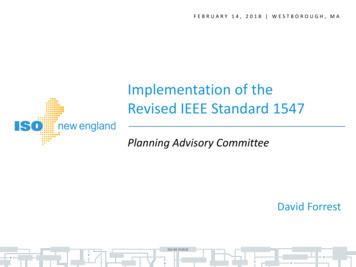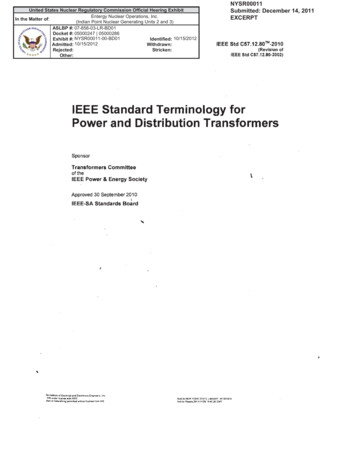
Transcription
IEEE INTERNET OF THINGS JOURNAL, VOL. 1, NO. 1, FEBRUARY 201481Time-Reversal Wireless Paradigm for GreenInternet of Things: An OverviewYan Chen, Member, IEEE, Feng Han, Member, IEEE, Yu-Han Yang, Student Member, IEEE, Hang Ma, Yi Han,Chunxiao Jiang, Member, IEEE, Hung-Quoc Lai, Member, IEEE, David Claffey, Zoltan Safar, andK. J. Ray Liu, Fellow, IEEEAbstract—In this paper, we present an overview of the timereversal (TR) wireless paradigm for green Internet of Things (IoT).It is shown that the TR technique is a promising technique thatfocuses signal waves in both time and space domains. The uniqueasymmetric architecture significantly reduces the cost of the terminaldevices, the total number of which is expected to be very large for IoT.The focusing effect of the TR technique can harvest the energy of allthe multi-paths at the receiver, which improves the energy efficiencyof the wireless transmission and thus the battery life of terminaldevices in IoT. Facilitated by the high-resolution spatial focusing, theTR division multiple access scheme leverages the uniqueness of themulti-path profiles in the rich-scattering environment and mapsthem into location-specific signatures, so that spatial multiplexingcan be achieved for multiple users operating on the same spectrum.In addition, the TR system can easily support heterogeneous terminaldevices by providing various quality-of-service (QoS) optionsthrough adjusting the waveform and rate backoff factor. Finally,the unique location-specific signature in TR system can provideadditional physical-layer security and thus can enhance the privacyand security of customers in IoT. All the advantages show that the TRtechnique is a promising paradigm for IoT.Index Terms—Internet of Things (IoT), spatial focusing,temporal focusing, time reversal (TR), time-reversal divisionmultiple access (TRDMA).I. INTRODUCTIONURING the past decade, the Internet of Things (IoT) hasdrawn great attention from both academia and industry,since it offers challenging notion of creating a world where all theDManuscript received October 30, 2013; revised January 28, 2014; acceptedFebruary 11, 2014. Date of publication February 27, 2014; date of current versionMay 05, 2014.Y. Chen, Y.-H. Yang, H. Ma, Y. Han, Z. Safar, and K. J. Ray Liu are withOrigin Wireless Communications Inc., College Park, MD 20742 USA, and alsowith the Department of Electrical and Computer Engineering, University ofMaryland, College Park, MD 20742 USA (e-mail: yan@umd.edu;yhyang@umd.edu; hangma@umd.edu; yhan1990@umd.edu; zsafar@umd.edu; kjrliu@umd.edu).F. Han was with the Department of Electrical and Computer Engineering,University of Maryland, MD 20742 USA, and with Origin WirelessCommunications Inc., College Park, MD 20742 USA. He is now withQualcomm Inc., San Diego, CA 92121 USA (e-mail: hanf@ieee.org).C. Jiang was with the Department of Electrical and Computer Engineering,University of Maryland, MD 20742 USA, and with Origin WirelessCommunications Inc., College Park, MD 20742 USA. He is now with theDepartment of Electronic Engineering, Tsinghua University, Beijing 100084,China (e-mail: chx.jiang@gmail.com).H.-Q. Lai and D. Claffey are with Origin Wireless Communications Inc.,College Park, MD 20742 USA (e-mail: inwirelesscomm.com).Color versions of one or more of the figures in this paper are available online athttp://ieeexplore.ieee.org.Digital Object Identifier 10.1109/JIOT.2014.2308838things, known as smart objects [1], around us are connected,typically in a wireless manner, to the Internet and communicatewith each other with minimum human intervention [2]–[4]. Anexample of IoT system is shown in Fig. 1. The ultimate goal ofIoT is to create a better world where things around us know whatwe like, what we want, and what we need and act accordinglywithout explicit instructions [5], and thus improve the quality ofour lives and consistently reduce the ecological impact ofmankind on the planet [6].The term “IoT” was first proposed by Kevin Ashton in hispresentation at Procter&Gamble (P&G) in 1999 [7]. During thepresentation, Ashton envisioned the potential of IoT by stating“The Internet of Things has the potential to change the world, justas the Internet did. Maybe even more so.” Such a concept thenbecame popular when the MIT Auto-ID center presented theirvision of IoT in 2001 [8]. In 2005, IoT was formally introducedby the International Telecommunication Union (ITU) throughthe ITU Internet report [9].With a very broad vision, IoT has shown its great potential toimprove the quality of our lives. However, the research into theIoT is still in its infancy and there are still a lot of challengesneeded to be addressed before the realization of IoT. In thefollowing, we summarize some key technical challenges fromthe perspective of wireless communication, which is the essentialtechnology of IoT to allow people and things to connect toInternet anywhere at anytime [10]1) Better battery life: Typically the things in IoT are poweredwith small batteries, due to which the power consumptionis low and thus requires low computational complexity ofthe wireless communication techniques.2) Multiple active things: The IoT is expected to have manyconcurrent active things transmitting data, which leads tosevere interference among things. Thus, low interferencewireless technologies are desired.3) Low-cost terminal devices: For widespread adoption of theIoT technology, the cost at the terminal devices, i.e., things,needs to be low. Therefore, simple processing at theterminal devices’ side is preferred.4) Heterogeneous terminal devices: Different from currentwireless systems that have a collection of rather uniformdevices, it is to be expected that the IoT will exhibit a muchhigher level of heterogeneity, as things that are totallydifferent in terms of functionality, technology and application fields will belong to the same communicationenvironment. Thus, the wireless solution to IoT shouldbe able to support heterogeneous terminal devices with2327-4662 2014 IEEE. Personal use is permitted, but republication/redistribution requires IEEE permission.See http://www.ieee.org/publications standards/publications/rights/index.html for more information.
82IEEE INTERNET OF THINGS JOURNAL, VOL. 1, NO. 1, FEBRUARY 2014Fig. 1. Illustration of TR system for IoT.different quality-of-service (QoS) options such as fromvery low bit rate to very high.5) Scalability: The density of the things in IoT may be veryhigh or low, which requires the wireless technology to behighly scalable to provide satisfactory QoS for low to highdensity areas.6) Privacy and security: Since every thing in IoT has a uniqueidentification, there is a need to have a technically soundsolution to guarantee privacy and the security of thecustomers in order to have a widespread adoption of IoT.To qualify as a good wireless communication solution to IoT, atechnology should be able to handle the challenges raised above.Currently existing wireless technologies for IoT can be classifiedinto two groups: 1) wireless technologies for low-data-rate andlow-power applications such as remote control [11], [12]; and2) wireless technologies for high-data-rate applications such asvideo streaming [13]–[17]. Note that the technologies suitablefor low-data-rate applications may not be able to meet therequirements of the high-data-rate applications.A typical wireless communication technology suitable for lowpower, low-data-rate applications is ZigBee [11]. Mainly basedon IEEE 802.15.4, ZigBee can operate in the 868 MHz, 915 MHz,and 2.4 GHz bands with respective data rates of 20, 40, and250 kb/s. A similar technology is Z-Wave [12], whose mainpurpose is to enable short message transmission from a controlnode to multiple nodes. The maximum speed of Z-Wave is200 kb/s working at 2.4-GHz band. The most significant advantage of ZigBee and Z-Wave is the low price [18], [19]. Forinstance, there existchips including RF module, thedigital baseband module, and a programmable microcontroller.Both of these technologies were designed for low-power applications in battery-operated devices. Moreover, ZigBee evenincludes a sleep-mode mechanism to reduce power consumption.The complexity of hardware is quite low: 32–128 kbytes ofmemory is enough to implement the system including the higherlayers. On the other hand, the most obvious disadvantage ofZigBee and Z-Wave is their low data rate. Moreover, the 2.4GHz frequency band is already crowded with interfering devices,e.g., microwave ovens, WiFi equipment, and cordless phones.The sub-GHz electromagnetic (EM) waves propagate very far, sovery high node density may not be achievable due to the highinterference levels created by other similar devices.The most popular technologies for high-data-rate applicationsare Bluetooth [13] and WiFi [14]. Bluetooth, based on IEEE802.15.1, is a wireless technology for exchanging data over shortdistance. Compared with ZigBee and Z-Wave, the data rate couldbe increased to megabit per second (Mbps). WiFi, based on IEEE802.11, is a popular technology that allows an electronic deviceto exchange data or connect to the Internet wirelessly. The speedof WiFi can achieve up to several gigabit per second (Gbps)according to IEEE 802.11ac with the help of MIMO and veryhigh-order modulation. The most important advantage of these
CHEN et al.: TR WIRELESS PARADIGM FOR GREEN IoTtwo technologies is the high data rate. However, they requirehigher power consumption, higher complexity of hardware(MIMO in WiFi) and thus higher price [20]. Since both transmitter and receiver use the same architecture, i.e., symmetricarchitecture is used, the power consumption of terminal devicesis high. In addition, a large number of WiFi access points (APs)deployed close to each other operating in the same or adjacentchannels will severely interfere with each other. Thus, thesetechnologies do not seem to offer robust performance in interference-limited scenarios even with costly terminal devices.Another possible technology is the 3G/4G mobile communications [21]–[23]. However, the poor indoor coverage of 3G/4Gsignals greatly limit its application to IoT, where communications mostly happen in indoor environment.From the above discussions, we can see that existing technologies can only address partial challenges while leaving the restunaddressed, e.g., both the heterogeneity and scalability challengescannot be handled by existing technologies. A natural question toask is: is there a wireless communication technique that can addressmost, if not all, challenges? As pointed out in [24], time-reversal(TR) signal transmission is an ideal paradigm for low-complexity,low energy consumption green wireless communication becauseof its inherent nature to fully harvest energy from the surroundingenvironment by exploiting the multi-path propagation to recollectall the signal energy that could be collected as the ideal RAKEreceiver. The theoretic analysis in [24] shows that a typical TRsystem has a potential of over an order of magnitude of reduction inpower consumption and interference alleviation, which means thatTR system can provide better battery life and support multipleconcurrent active users. Moreover, with our proposed asymmetricTR architecture, only one-tap detection is needed at the receiverside [25], thus the computational complexity at the terminaldevices is low, which means the cost of the terminal devices isalso low. Note that the achievable rate can still be very high whenthe bandwidth is wide enough as shown in [26]. In addition, the TRsystem can easily support heterogeneous terminal devices byproviding various QoS options through adjusting the waveformand backoff factor [25], [27]. Finally, the unique location-specificsignature in TR system can provide additional physical-layersecurity and thus can enhance the privacy and security of customers in IoT [24]. Overall, we will provide an overview to show thatTR technique is an ideal paradigm for IoT.The rest of the paper is organized as follows. In Section II, weintroduce some basic concepts of TR technique. Then, we proposein Section III an asymmetric TR division multiple access (TRDMA)architecture and discuss in details why TR is an ideal paradigm forIoT. In Section IV, we discuss other challenging issues and futuredirections including advanced waveform design, MAC layer issues,and low-cost high-speed analog-to-digital converter (ADC) andDAC. Finally, we draw conclusions in Section V.II. SOME BASICS OF TRA. The Basic Principles of TRThe TR signal processing is a technology to focus the power ofsignal waves in both time and space domains. The research of TRcan date back to early 1970s, when phase conjugation was firstobserved and studied by Zeldovich et al. [28]. Unlike the phase83Fig. 2. Time reversal signal processing principle.conjugation that uses an holographic or parametric pumping[29], the TR uses transducers to record the signal waves andenables signal processing on the recorded waveforms.The TR signal processing was applied by Fink et al. in 1989[30], followed by a series of theoretical and experimental worksin acoustic communications [31]–[38]. As found in acousticphysics [30]–[34] and then further validated in practical underwater propagation environments [35]–[37], the energy of the TRacoustic waves from transmitters could be refocused only at theintended location with very high spatial resolution. Since TR canmake full use of multi-path propagation and also requires nocomplicated channel processing and equalization, it was laterverified and tested in wireless radio communication systems.Experimental validations of TR technique with EM waves havebeen conducted in [24], [39]–[45], including the demonstrationof spatial and temporal focusing properties [24], [39]–[45] andchannel reciprocity [24], [41]. The feasibility of applying TRtechnique into ultra-wideband (UWB) communications has beenstudied in [46]–[48] with the focus on the bit error rate (BER)performance through simulation. A system-level theoreticalinvestigation and comprehensive performance analysis of aTR-based multiuser communication system was conducted in[25], where the concept of TRDMA was proposed. To improvethe performance of the TRDMA systems, interference suppression through waveform design [27], [49] and interference cancelation [50] are proposed. The implementation complexity issueis studied in [26], [51], and [52]. Moreover, as shown in [53],[54], with random scatterers, TR can achieve focusing that is farbeyond the diffraction limit, i.e., half wavelength.The principle of TR transmission is very simple, as demonstrated in Fig. 2. In this figure, when transceiver A wants totransmit information to transceiver B, transceiver B first has tosend an impulse-like pilot signal that propagates through ascattering and multi-path environment and the resulting waveforms are received and recorded by transceiver A. This is calledchannel probing phase. After that, transceiver A simply timereverses (and conjugated, if the signal is complex valued) thereceived waveform and then transmits it back through the samechannel to transceiver B. This is called TR-transmission phase.There are two basic assumptions for the TR communicationsystem to work.1) Channel reciprocity: the impulse responses of the forwardlink channel and the backward link channel are assumed tobe identical.2) Channel stationarity: the channel impulse responses(CIRs) are assumed to be stationary for at least oneprobing-and-transmitting cycle.
84IEEE INTERNET OF THINGS JOURNAL, VOL. 1, NO. 1, FEBRUARY 2014Fig. 3. Correlation of channel responses at different time epochs [24].Fig. 4. Temporal focusing effect obtained from experiments [24].These two assumptions generally hold in reality, especially forindoor environment, as validated through real experiments in[55] and [24]. In [55], Qiu et al. conducted experiments in acampus lab area and showed that the correlation between theimpulse response of the forward link channel and that of backward link channel is as high as about 0.98, which means that thechannel is highly reciprocal. In [24], Wang et al. showed withexperimental results that the multi-path channel of an officeenvironment is actually not changing a lot. In their experiment,Want et al. measured the channel information every one minute,and a total of 40 channel snapshots were taken and stored, wherethe first 20 snapshots correspond to a static environment, snapshots 21 to 30 correspond to a moderately varying environment,and snapshots 31 to 40 correspond to a varying environment. Theexperimental results are shown in Fig. 3, where we can see thatmost the correlation coefficients between different snapshots arehigher than 0.8 and those between static snapshots are above0.95, which means that the channel is highly stationary.By utilizing channel reciprocity, the re-emitted TR waves canretrace the incoming paths, ending up with a constructive sum ofsignals of all the paths at the intended location and a “spiky”signal-power distribution over the space, as commonly referredto as spatial focusing effect. Also from the signal processingpoint of view, in the point-to-point communications, TR essentially leverages the multi-path channel as a matched filter andfocuses the wave in the time domain as well, as commonlyreferred as temporal focusing effect. By treating the environmentas a facilitating matched filter computing machine, the complexity of TR systems is significantly reduced, which is ideal for IoTapplications as we will discuss later.B. Temporal Focusing and Spatial Focusing of TRIn principle, the mechanisms of reflection, diffraction, andscattering in wireless medium give rise to the uniqueness andindependence of the CIR of each multi-path communication link[56]. Obtained from real indoor experiments [24], Figs. 4 and 5show that, when the re-emitted TR waves from transceiver Apropagate in the wireless medium, the location of transceiver B isFig. 5. Spatial focusing effect obtained from experiments [24].the only location that is associated with the reciprocal CIR. Thatis to say that given the re-emitted TR waveform from transceiverA that is specific to the CIR between transceivers A and B, theenvironment will serve as a natural matched filter only for theintended transceiver B. As a result, the temporal focusing effectof the specific re-emitted TR waveform can be observed only atthe location of transceiver B. It means that at the time instance oftime focusing, the signal power not only exhibits a strong peak inthe time domain at transceiver B as shown in Fig. 4, but alsoconcentrates spatially only at the location of transceiver B in therich multi-path environments as shown in Fig. 5. A physicalmeaning is that at this moment, it creates a resonating effect dueto the TR transmission.Experimental results in both acoustic/ultrasound domain andradio frequency (RF) domain further verified the temporalfocusing and spatial focusing effects of the TR transmission, aspredicted by theory. Fink et al. [30]–[34] found that acousticenergy can be refocused on the source with very high resolution
CHEN et al.: TR WIRELESS PARADIGM FOR GREEN IoT85Fig. 6. Basic time reversal communications.(wavelength level). In [35]–[37], acoustics experiments in theocean were conducted to validate the focusing effects of TR inreal underwater propagation environments. In the RF domain,experiments in [39], [40], and [46] demonstrated the spatial andtemporal focusing properties of EM signal transmission with TRby taking measurements in RF communications. Furthermore, aTR-based interference canceler to mitigate the effect of clutterwas presented in [57], and target detection in a highly clutteredenvironment using TR was investigated in [58] and [59]. In [24],real-life RF experiment results were obtained in typical indoorenvironments, which shows the great potential of TR as a newparadigm of the green wireless communications.In the context of communication systems, the temporal focusing effect concentrates a large portion of the useful signal energyof each symbol within a short time interval, which effectivelysuppresses the inter-symbol interference (ISI) for high-speedbroadband communications. The spatial focusing effect allowsthe signal energy to be harvested at the intended location andreduces leakage to other locations, leading to a reduced requiredtransmit power consumption and lower co-channel interferenceto other locations. The benefits and unique advantages of TRbased communication systems due to the temporal and spatialfocusing effects promise a great potential for the applications ofIoT, as will be discussed in the remaining parts of this paper.C. TR Communication SystemA very simple TR-based communication system is shown inFig. 6. The CIR between the two transceivers is modeled aswhere is the complex channel gain of the th path of the CIR,andis the corresponding path delay, and the is the totalnumber of the underlying multi-paths (assuming infinite systembandwidth and time resolution). Without loss of generality, weassume thatin the following discussion, i.e., the first patharrives at time, and as a result, the delay spread of the multipath channel is given by.Constrained by the limited bandwidth of practical communication system, pulse shaping filters are typically used to limit theeffective bandwidth of the transmission. Generally, the durationis limited by the available bandwidth throughof the pulsethe simple relation.1) Channel Probing Phase: Prior to transceiver A’s TRtransmission, transceiver B first sends out a pulseofduration(other than an ideal impulse which demandsinfinite bandwidth) which propagates to transceiver A throughthe multi-path channel, where transceiver A keeps a recordof the received waveform, which is the convolution ofand, represented as follows: wherecan be treated as an equivalent channel response forthe system with a limited bandwidth . From (2), one can see thatfor those paths whose time differences are less than the pulseduration , they are mixed together due to the limited systembandwidth . Also for , the received valuesandare determined by completely different sets of paths.Therefore, given a limited bandwidth , the corresponding pulsedurationdetermines the time-domain resolution to resolvetwo adjacent paths. In other words, from the system’sperspective, those paths whose time differences are within thedurationare treated like one path in the equivalent channelresponse.2) Data Transmission Phase: Upon receiving the waveform,transceiver A time-reverses (and conjugate, when complexvalued) the received waveform, and uses the normalizedTR waveform as a basic signature waveform, i.e.,Defining represented asand ,in (3) can beAt transceiver A, there is a sequence of informationsymbolsto be transmitted to transceiver B. Typically,
86IEEE INTERNET OF THINGS JOURNAL, VOL. 1, NO. 1, FEBRUARY 2014Fig. 7. Basic TR communications with equivalent channel response.the symbol rate can be much lower than the system chip rate.1Therefore, a rate backoff factoris introduced to match thesymbol rate with the chip rate by insertingzerosbetween two symbols [24], [25], [46], [60]. Applying thepulse shaping filter,As the receiver, transceiver B simply samples the receivedseconds at,3 for, insignal everyorder to detect the symbolZand the transmitted signal2 can be expressed asZThe signal received at transceiver B is the convolution ofand, plus additive white Gaussian noise (AWGN)withzero-mean and variance, i.e.,where .Consequently, the resulting signal-to-interference-plus-noiseratio (SINR) is obtained asZZwhereand.Thanks to the temporal focusing, when, thepower ofachieves its maximum for, i.e.,12The duration of each chip isassuming that each information symbolhas unit power.3) An Equivalent System Model with LimitedBandwidth: Based on (2)–(10), one can come up with anequivalent system model shown in Fig. 7 for the system withlimited system bandwidth as shown in Fig. 6. In the equivalentsystem model,is treated as the effectivechannel response for such a finite-bandwidth system, takinginto account the use of the band-limiting pulse shaping filter. Accordingly, the time-reversed (and conjugated) version ofthe equivalent channel responseis thecorresponding TR signature waveform for the equivalent model.Note that in this paper, the base-band system model is considered. As a result,no RF components are included in the system diagrams.3It is assumed here that the synchronization has been achieved at a referencetime, without loss of generality.
CHEN et al.: TR WIRELESS PARADIGM FOR GREEN IoT87Fig. 8. Basic diagram of the TRDMA downlink.In the following discussion of the TRDMA scheme in thispaper, we use the simpler equivalent model by looking at theeffective channel response, which can beverified by comparing Figs. 6 and 7.to the BS, so that the TR mirror at the BS can record and timereverse (and conjugate, if complex-valued) the received wave, and use the TR waveformas the basic signatureformwaveform, given by6III. ASYMMETRIC TRDMA ARCHITECTURE FOR IOTBased on TR technique, we recently introduced in [25] a novelmulti-user media access scheme, TRDMA, for wideband communication. Leveraging the unique temporal and spatial focusingeffects of the TR technique [24], [61], the TRDMA exploits thespatial degrees of freedom of the environment and uses the multipath channel profile associated with each user’s location as alocation-specific signature for the user. Moreover, such channelprofiles may be further improved by mixing spatial degreesof freedom and temporal degrees of freedom as shown in [62]and [63].With the concept of TRDMA, in this section, we propose anasymmetric TRDMA architecture for IoT, where most of thecomputational complexities are concentrated at the more powerful base station (BS), resulting in a minimal complexity andcost at the terminal devices in both uplink and downlink. Asshown in Fig. 1, the proposed IoT system consists of multiple TRBSs and each BS serves multiple heterogeneous terminal devices, which ranges from laptop and TV to light and clothes. Inthe following, we will first focus on the single BS scenario andthen discuss the multiple-BS scenario in Section III-E.A. Channel Probing PhaseConsider a wireless broadband multi-user network that consistsof one BS and terminal users.4 Each user communicates withBS simultaneously over the same spectrum. Assuming a richscattering environment, each user’s location is associated with aunique (effective) channel response,.The channel probing occurs when a terminal user joins thenetwork, and periodically afterwards.5 The channel probingprocess is performed for one user at a time. For the th user’schannel probing, the terminal user first sends a pulse pilot signal4In this paper, users and devices are interchangeable.5In general, the probing period depends on how fast the channel may vary.B. Data Transmission Phase—DownlinkAfter the channel recording phase, the system starts its datatransmission phase. We first introduce the downlink scheme inthis part. In the downlink scheme, at the BS, each ofrepresents a sequence of informationsymbols that are independent complex random variables withzero mean. As shown in Fig. 8, we allow different users to adoptdifferent rate backoff factors to accommodate the heterogeneousQoS requirement of the applications of IoT.To implement the rate backoff, the th sequence is first upsampled by a factor ofat the BS, and the th up-sampledsequence can be expressed asThen the up-sampled sequences are used to modulate thesignature waveforms, by calculating the convolution of the th up-sampled sequenceand the TRwaveformas shown in Fig. 8.After that, all the signals are combined together, and thecombined signalto be transmitted is given byZZ6As we mentioned in Section II, we use the effective channel response forfinite-bandwidth system.
88IEEE INTERNET OF THINGS JOURNAL, VOL. 1, NO. 1, FEBRUARY 2014Fig. 9. Basic diagram of the TRDMA uplink.In essence, by convolving the information symbol sequenceswith TR waveforms, the TR structure provides a mechanism ofembedding the unique location-specific signature associatedwith each communication link into the transmitted signal forthe intended user.The signal received at user is represented as follows:ZThanks to the spatial focusing effect, in (16), when, thepower ofis typically very small compared tothe power of the, which suppresses the inter-userinterference (IUI) for the TRDMA downlink.Consequently, based on (15), the resulting SINR for user inthe TRDMA downlink is given bywherewhich is the convolution of the transmitted signaland the, plus an AWGN sequencewith zerochannel responsemean and variance.Thanks to the temporal focusing effect, the th receiver (user )simply samples the received signal everyseconds at, ending up withgiven as follows:andC. Data Transmission Phase—Uplinkwhere, and In this part, we describe the TRDMA uplink scheme, whichfacilitated, together with the downlink scheme, the asymmetricTRDMA architecture for IoT. Given the asymmetric complexitydistribution between BS and terminal users in the downlink, thedesign philosophy of such a uplink is to keep the complexity ofterminal users at minimal level.In the TRDMA uplink,users simultaneously transmitindependent messagesto the BSthrough the multi-path channels. Similar to the downlink scheme,the rate backoff factor is introduced to match the symbol ratewith the system’s chip rate. For any user ,,the rate matching process is performed by up-sampling thesymbol sequenceby a factor , as shown in Fig. 9.
CHEN et al.: TR WIRELESS PARADIGM FOR GREEN IoT89Fig. 10. Performance comparison between TRDMA and UWB in terms ofaverage achievable data rate per user.Fig. 11. Performance comparison between TRDMA and UWB in terms ofnumber of supported users.The up-sampled sequence of modulated symbols for user can beexpressed asin which the
according to IEEE 802.11ac with the help of MIMO and very high-order modulation. The most important advantage of these Fig. 1. Illustration of TR system for IoT. 82 IEEE











